Your cart is currently empty!
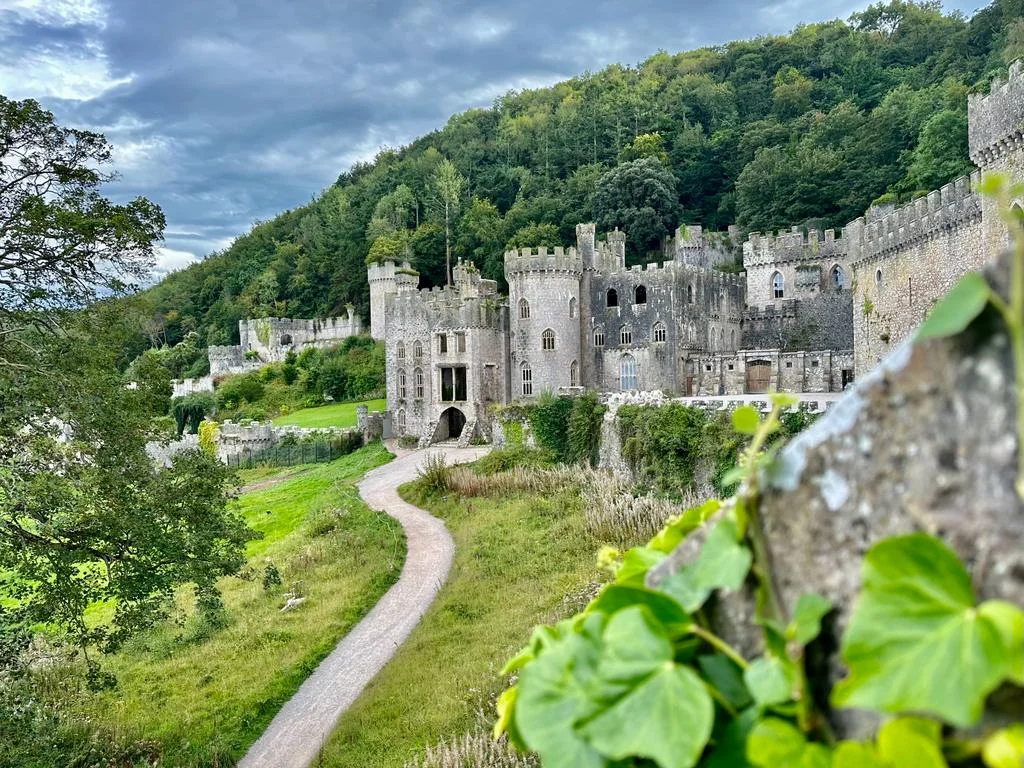
Gwrych Castle – The postwar years
Gwrych Castle is not a real castle but an 1820s manor house that was designed to look like one. But the architects did a great job and the end result is authentic, imposing and highly attractive. The history of castle prior to World War 2 has well covered elsewhere so I’ll be focusing on what happened after the war and covering the era of Leslie Salts.
Leslie Salts buys a castle
In July 1946 the empty castle and 370 acres of land was acquired for £12,000 by Jesse Rennie who announced it would become a private residence for himself and his parents. He later opened a restaurant and applied for an alcohol license, but was turned down. In October of that year he sold the castle to Merseyside businessman Leslie Salts and went off to buy another mansion in Anglesey, which later burned down. Rennie was declared bankrupt in 1970.
Leslie Salts was an astute businessman who started his career as a commercial artist before founding his own advertising agency. He went on to establish many successful ventures ranging from cosmetics to medicine to holiday camps. By the age of 30, he’d become a millionaire and, not surprisingly, had earned a rather ruthless reputation.
He announced that the castle would be open to day visitors and wasted no time installing a wealth of new attractions for the 1949 season. The sloping east lawn was turned into a natural amphitheater accommodating 2000 people. Concerts were staged featuring singers, musicians, choirs and hypnotists. A huge marquee was installed for indoor concerts featuring an impressive £2,000 Hammond organ. The stables were converted into an upmarket cafe complete with French chef. Salts was a gifted artist and many of his own paintings adorned the castle walls. The entire place was floodlit at night. It was said that 350,000 people attended that first summer.
Unlike today’s tourist attractions, where a single admission price often includes everything, back then visitors paid a small entry fee to get into the grounds with each attraction often having its own often additional charge.
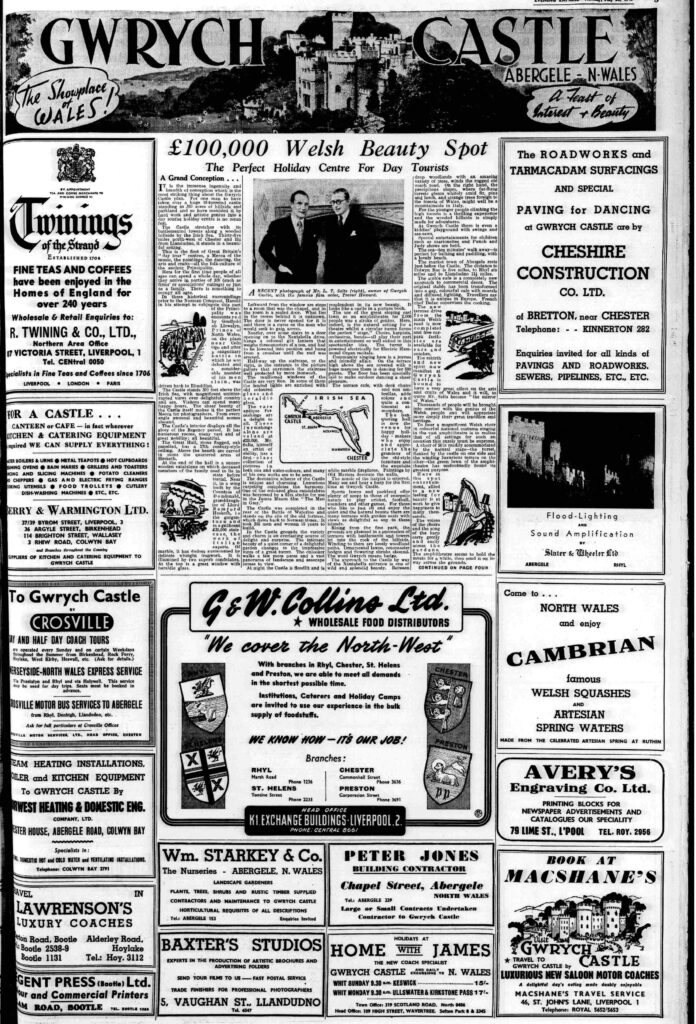
In 1950, new attractions were added including a petting zoo, a monkey house and an aquarium. A miniature railway was built by Ernest Dove who operated the trains with his son Ken. Two steam engines were supplied named ‘Silver Queen’ and ‘Belle of New York’. Ken would later become the castle manager and resident director.
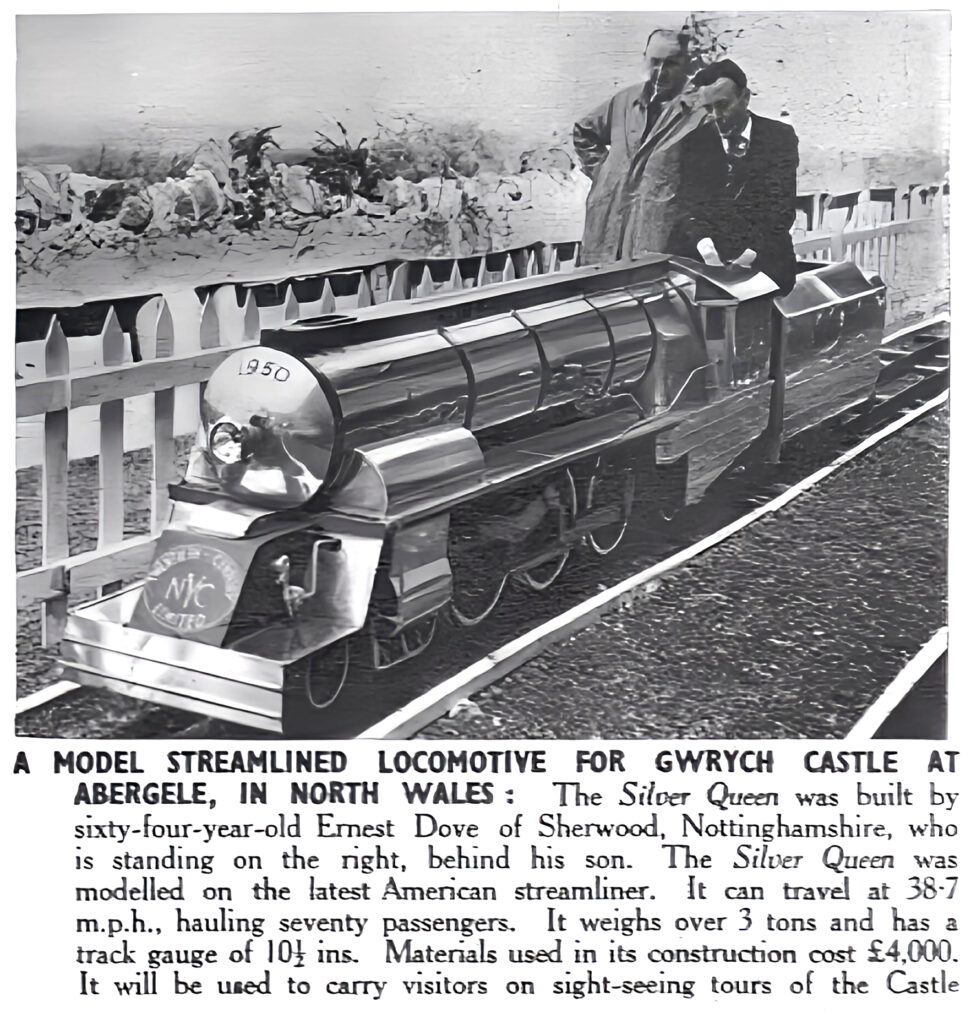
Five caves behind the house—said to have been sealed for over a century—were reopened and turned into themed Grottos with modern lighting. Later that summer the excitement was overshadowed when the body of a baby boy was found in one of the caves, with an autopsy revealing he’d been smothered. A murder investigation was launched, and Scotland Yard got involved. Police spent weeks interviewing guests who had visited the castle in the preceding weeks, but ultimately, no one was brought to justice. It seems that the caves were closed shortly after as they’re not mentioned again in any of the publicity.
In May 1950 Salts was able to persuade boxer Bruce Woodcock to live and train at the castle in preparation for his upcoming World title fight with Lee Savold. At the time Bruce held the British, European and Empire Heavyweight titles and was a huge celebrity. In the space of just one month 174,000 people showed up to watch him work out on the east lawn. 80% of them were said to be women. On one day alone 27,000 people were admitted with thousands more being turned away, Traffic jams in the area stretched for 8 miles.

Woodcock went on to lose the fight and retired later that year. But the large crowds convinced Salts to encourage more boxers to use the grounds as their training camp. Later that year Freddie Mills make a week-long appearance followed by a 3-week stay by Randolph Turpin. Later that year Turpin became the British Middleweight Champion after defeating Albert Finch. Turpin returned to the castle in 1951 and began attracting large crowds of his own.
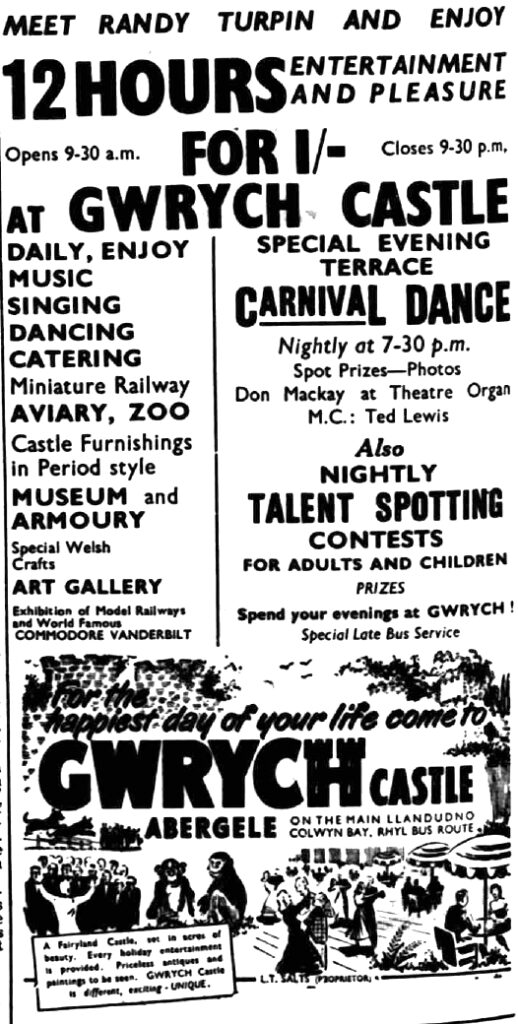
In July of that year Turpin stunned the nation by winning the world middleweight championship by defeating Sugar Ray Robinson in front of 18,000 fans at Earls Court. He lost the title just 64 days later but it didn’t seem to matter to his adoring fans
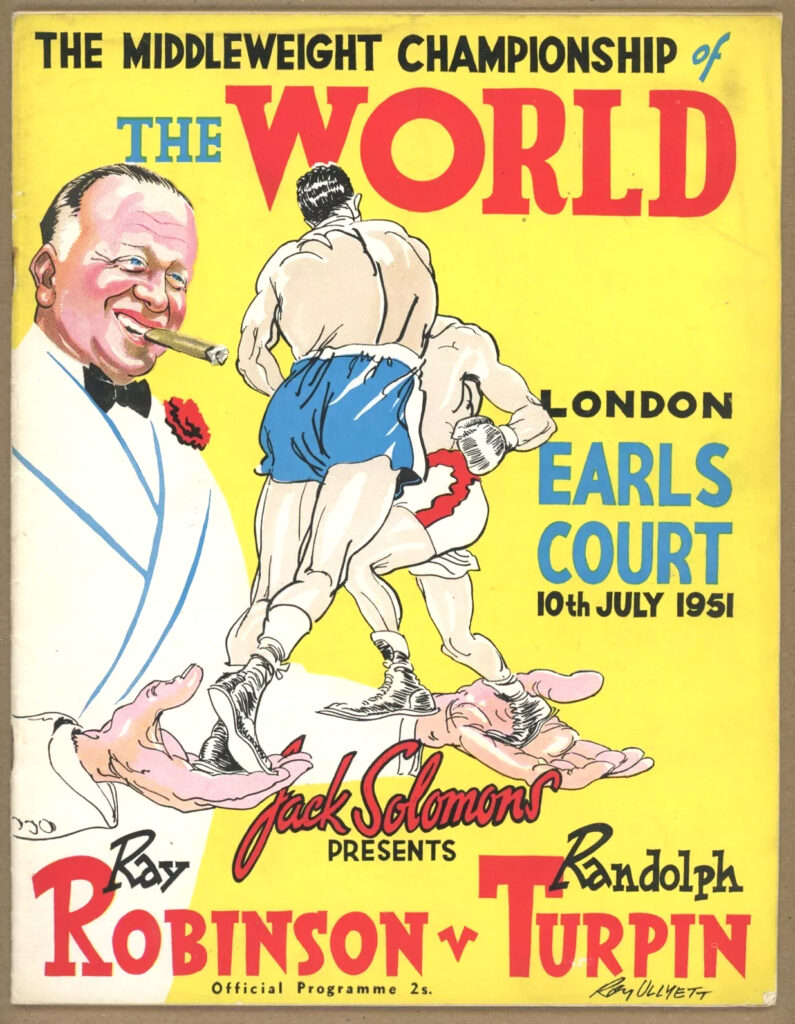
Turpin returned to Gwrych in 1952 where he was advertised as “The Greatest Attraction in Britain”. The huge crowds soon followed. He later complained that he never got a share of the money that the castle was raking in. Turpin’s manager, George Middleton, always had an uneasy relationship with Salts and once described him as a “conman”. He urged Turpin not to get involved in any business dealings with him. So it came as quite a shock when Turpin announced he was going into business with Salts to build miniature railways. They formed the International Miniature Railway Company and announced they’d be building a railway in Fleetwood along with others “all around the world”.
Turpin also announced that Salts had become his “business manager and financial advisor” and Salts even started attending his fights. He also applied for a boxing managers license which upset Middleton and led to all sorts of wild rumours.
Salts & Turpin buy a holiday complex
In September 1952 they partnered in a much bigger venture when they spent £10,000 to buy the Summit Complex on top of the Great Orme in Llandudno. Consisting of a restaurant and gift shop, along with a disused hotel, they soon added more attractions including ‘Randy’s Bar’, an outdoor boxing ring, a small theatre and of course a miniature railway. The ‘Silver Belle” locomotive from Gwrych, which had been rebuilt and renamed to ‘Commodore Vanderbilt’ was sent up to run the trains. Ernest Dove laid the track. It all opened to the public at Easter 1953.


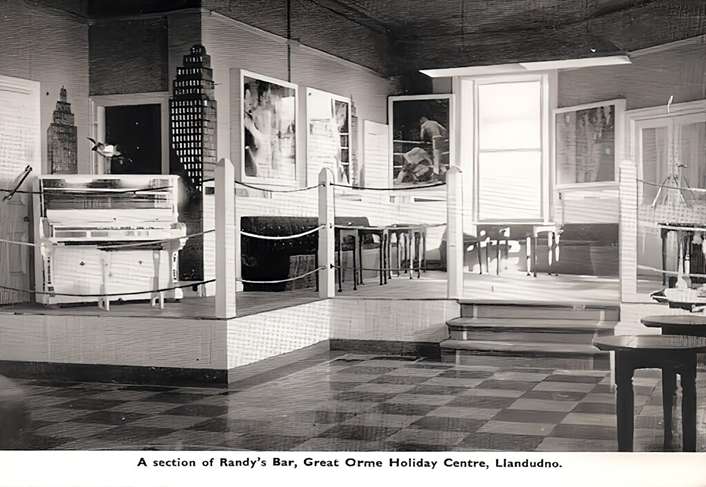

Later that year, Charles Royle, MP for Salford West, complained that the beauty spot was being ruined “I found slot machines, a boxing ring, photographers taking pictures around a cardboard ‘Randy’. Who permitted this monstrosity to come to my beloved Great Orme?”.
Turpin was still required to make personal appearances at the castle three evenings a week. Unfortunately the Summit Complex wasn’t the big money spinner that he was led to believe. Even though it was a joint venture, it was later discovered that Turpin had put up most of the cash to buy the place. He also paid for most of the new additions.
To the surprise of nobody, the partnership with Salts later ended on a sour note and Turpin was stuck running the place on his own. Most of the new attractions had closed within a year or two. He admitted that he was no businessman but he was also proud and rejected all offers of help by well-meaning people. His attitude was that he got himself into this mess and only he should get himself out of it.
In 1957 the gift shop was raided by police who removed a number of “obscene articles” including rubber dolls, educational toys and wooden wall plaques which contained “indecent inscriptions”. No charges were brought but 106 items were removed and destroyed.
The complex became a huge drain on his time and resources and he put in long hours to keep the business afloat. He could often be found working behind the bar. In 1959 Turpin was served a writ for unpaid taxes going back to his boxing days, and was forced to sell the Summit Complex in 1960.
His life later spiraled down into a dark place and the sad story is well covered elsewhere. By all accounts Turpin was a decent guy who lived life in the fast lane and took full advantage of his fame and fortune. Unfortunately he was used and abused by too many other people, and it all eventually caught up with him.
The castle continues to thrive
Meanwhile, back at the castle, things were going pretty good. Salts had lost interest in boxing, and after Turpin’s departure, no one else was invited along. In 1953, the Belle of New York steam engine was renamed President Eisenhower. Salts wrote to Eisenhower himself, requesting permission, and the president replied with a letter of approval. That signed letter was framed and displayed in the castle for many years. Salts was an advertising man and knew how to drum up publicity.
In 1956 the top floors of the building were converted into holiday flats (22 bedrooms with 3 shared bathrooms…). Demand was so high that Salts applied to build 41 chalets in the grounds, which was rejected by the council.
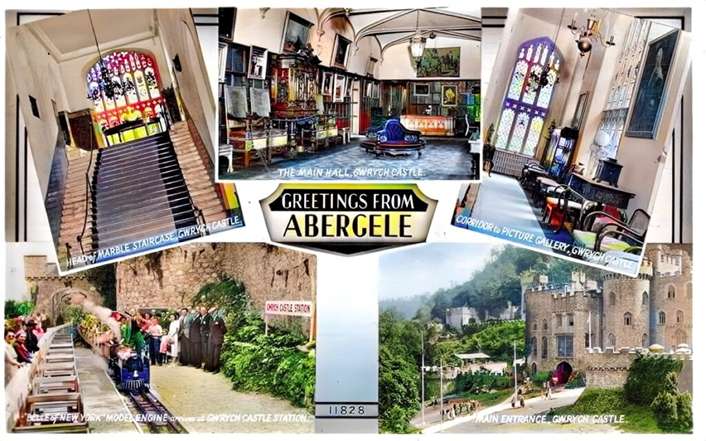

The 1960s saw a noticeable downturn in visitors as people sought more exciting activities elsewhere. A stuffy old castle was not high on the list. To appeal to a younger crowd, Salts transformed the French café into a trendy espresso coffee bar and built a Chamber of Horrors in the cellar. But it wasn’t enough to reverse the decline.
He realised he had to make some drastic changes so in 1963 he announced a £5 million plan to turn the castle into a hotel, and to redevelop the grounds with “1000 good-class houses within the £3500 to £6000 range”. To sweeten the deal he offered to build a new promenade and marina in nearby Abergele. The project would have increased the population of the town by 40 percent! The planning application dragged on for three years until it was rejected by the Secretary of State for Wales.
The castle is sold
In early 1967, Salts sold 92 acres of castle land to Abergele Golf Club for £40,000, allowing them to develop an 18-hole course that still exists today. That June, he sold the remaining castle property to a three-man consortium, with one member also buying his former Wrexham home, Bronwylfa Hall. However, the deal later fell through, and five months later, Salts sold the castle to Pentland Hick of Associated Pleasure Parks (APP) for £125,000. Hick, who had successfully transformed Flamingo Park Zoo (now Flamingoland) into a thriving attraction, had a strong background in leisure development and would go on to acquire several zoos across the UK.
The new owners quickly devised plans to build 270 “Swiss-style” holiday chalets, an outdoor swimming pool, and an extension to the miniature railway. However, despite Hick’s impressive track record, the plans were rejected by the council. In 1969, APP was acquired by Scotia Investments, who continued operating the castle.
60-year old Salts retired to the Isle of Man.and spent his final years living at the upscale Bolivia Mount estate near Ramsey. During his time at Gwrych it was estimated that 10 million people had passed through the gates. He later acquired several hotels on the island.
The castle turns Medieval
During the early-1970s, medieval events were all the rage. To cash in on this, the formal gardens were ripped out in 1972 to make way for a 2000-seat jousting arena (“the first to be built since the middle ages”). Shows were staged twice a day and were organised by the Nottingham Jousting Association. The miniature railway, now diesel powered, was renamed The Magic Dragon Railway – the locomotive was fitted with a rather ugly dragon head. Pony rides were available for kids. 60,000 people visited the site in 1972.
To continue with the theme, medieval banquets were introduced in 1973 and Scotia rebuilt the old dining hall to create a medieval banquet centre that could accommodate a hundred people. Six-course meals were served by “wenches watched over by heavily armored knights”. Mead, wine or ale were included in the £3.50 price (which had increased to £4 the following year). The hall could also be rented for private events and wedding receptions. The upstairs flats became staff accommodation with 30 to 40 people resident each summer.

In 1974 the decision was made to close the castle to day visitors and focus solely on the evening banquets. Colwyn Bay’s publicity manager said “North Wales can’t really afford to lose such a novel attraction. I hope it will return”. Unfortunately the banquets did not generate the expected returns and in November of that year the castle was put up for sale.
It was acquired by Darjeeling Holdings, a company run by two London businessmen who had recently sold off their tea plantations in India. They wasted no time in selling off the assets and in January 1975 an auction was held to get rid of “surplus contents” including chandeliers, wall hangings, cabinetry, an electric organ and other furniture and effects. Later that year two of the castle lodges were sold off.
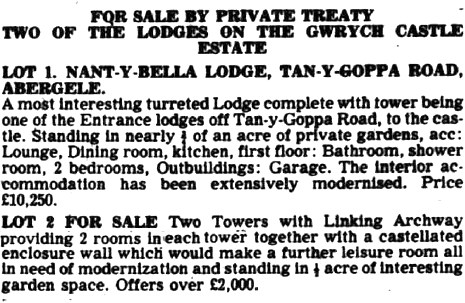
Medieval banquets continued but were scaled back to Saturdays only. For the summer of 1975, the grounds reopened to the public again, offering jousting, pony rides, and the miniature railway.
That August, a grand mock battle called “The Siege of Gwrych Castle” was organized by 1,500 members of the Sealed Knot Society, with all profits going to charity. While 40,000 visitors were expected, only 5,500 showed up—falling short of the 10,000 needed to even break even.
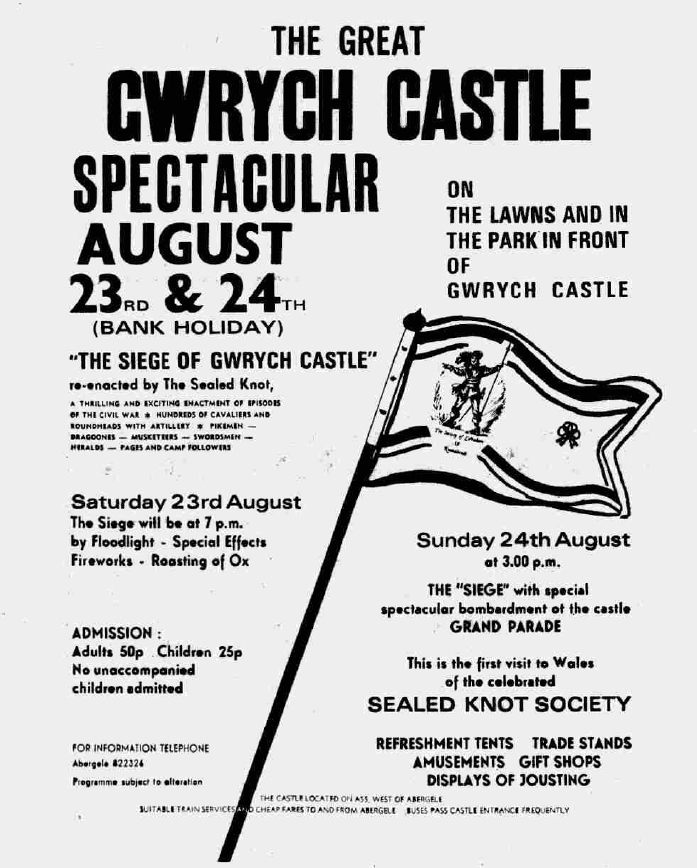
Following shareholder concerns, the Department of Trade announced an investigation into Darjeeling Holdings and shortly afterward the company went bankrupt. Control of the castle passed to the official receiver and it went back on the market in early 1976, listed at £250,000.
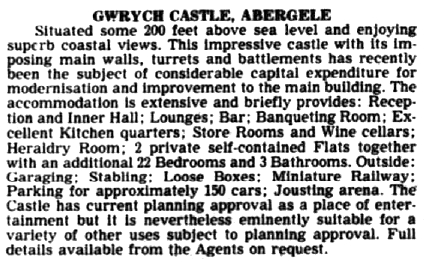
With the official receiver overseeing its affairs a member of the jousting team was offered residence at the castle in return for handling ‘light security’. He was also tasked with organising the jousting events, for which he received a share of the takings. He was later allowed to handle the bar so he started Friday night “discos” to boost income. The castle building remained closed, and the miniature Railway was out of action, but the grounds did open “for walks and picnics” for a fee of 10p (5p for kids). The jousting was an extra charge of 80p (40p for kids).
In January 1978 the site was sold to Thornwell Finance, run by Jack Waite. The new owners kicked out the live-in jouster, which resulted in an “altercation” followed by a court case. But everything else continued much the same. At Christmas 1979 part of the building was reopened as The Hunting Lodge Restaurant. In 1981 they started a Sunday market which grew to over a hundred stalls. A small funfair was set up in the car park.
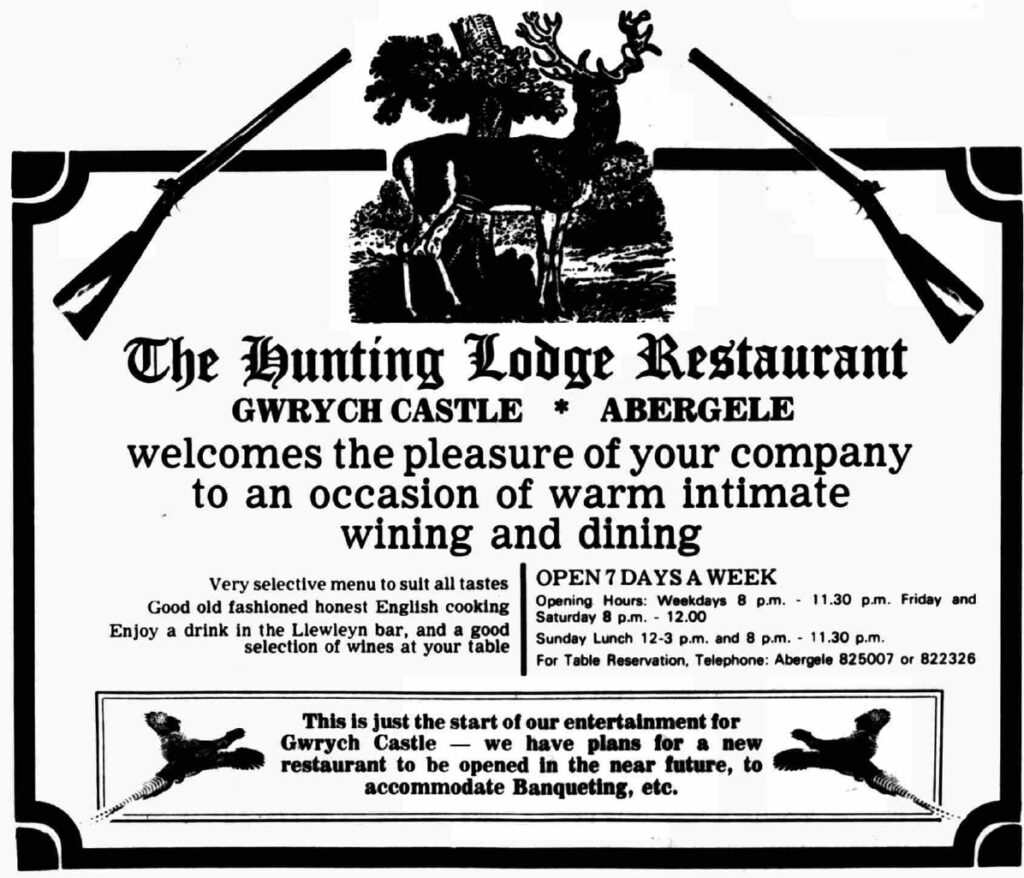
In June 1982 the castle was sold to Anglesey businesswoman Mrs Margaret Donald but, as with most previous owners, nothing much changed. The grounds remained open to the public while the house was closed and continuing to deteriorate. The council urged the owner to halt the building’s decline, but despite its Grade II listing, they found there was no legal obligation for the owner to maintain it in good condition.
The castle finally closes
In 1985 it all came to an end and the grounds were closed to the public. By this time, the house was described as “uninhabitable,” with most of the windows smashed out.
The jousting team, known as the “Knights of Gwrych Castle,” stayed together for a time, performing occasionally at events around the region. Meanwhile, throughout the late 1980s and early 1990s, the castle continued to attract visitors on an “unofficial” basis. With little to no staff or security present, people could show up and do whatever they wanted. Stories circulated of people swinging from chandeliers, trying on suits of armor, and even riding a moped down the grand staircase! During this period, numerous items were inevitably stolen or damaged.
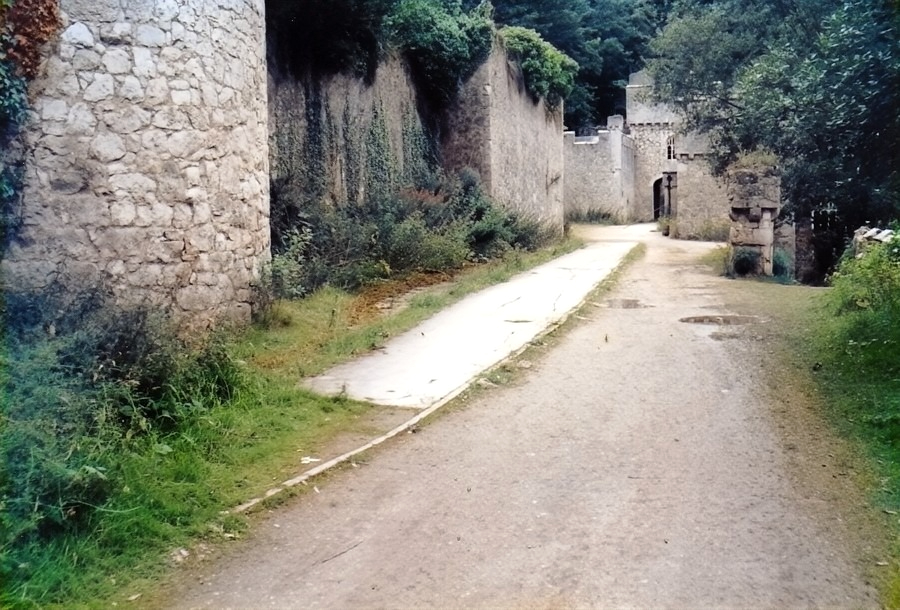
In 1990 the castle was bought by a Californian businessman who announced a £10 million plan to rebuild it as a five star hotel, conference centre and 2000-seat opera house. But yet again, nothing happened and three years later he announced he was “duped” into buying it.
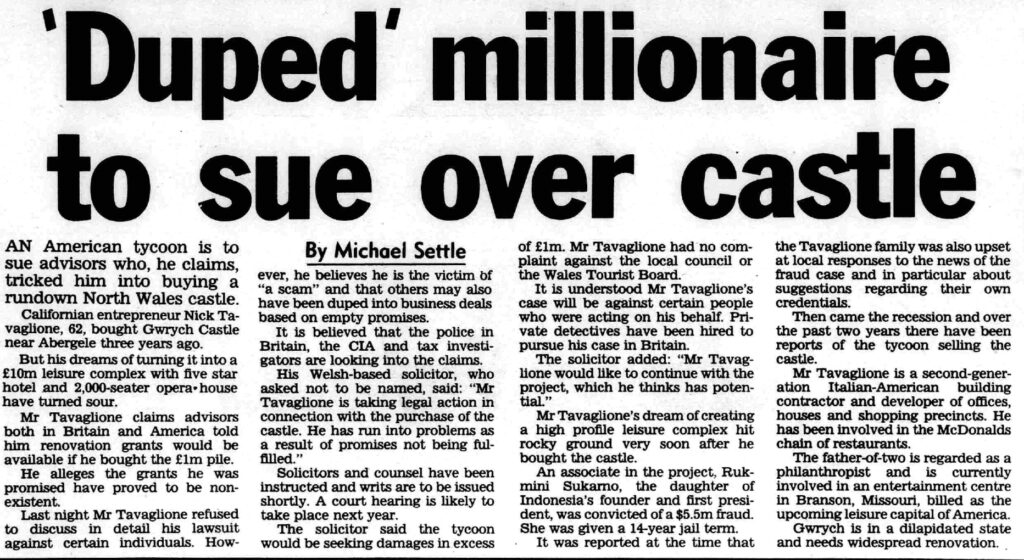
A mystery fire in 1994 destroyed part of building causing some of the floor to collapse into the cellar. In 1995 a group of travellers moved in and began stealing what was left. The roofing slates were sold and the interior wood was burned for heat. In 1996 a film crew arrived to film scenes for a movie called Prince Valiant. Surprisingly, the travelers remained and were moved out of the way during filming, but resumed their activities after the film crew left. The movie later flopped at the box office.
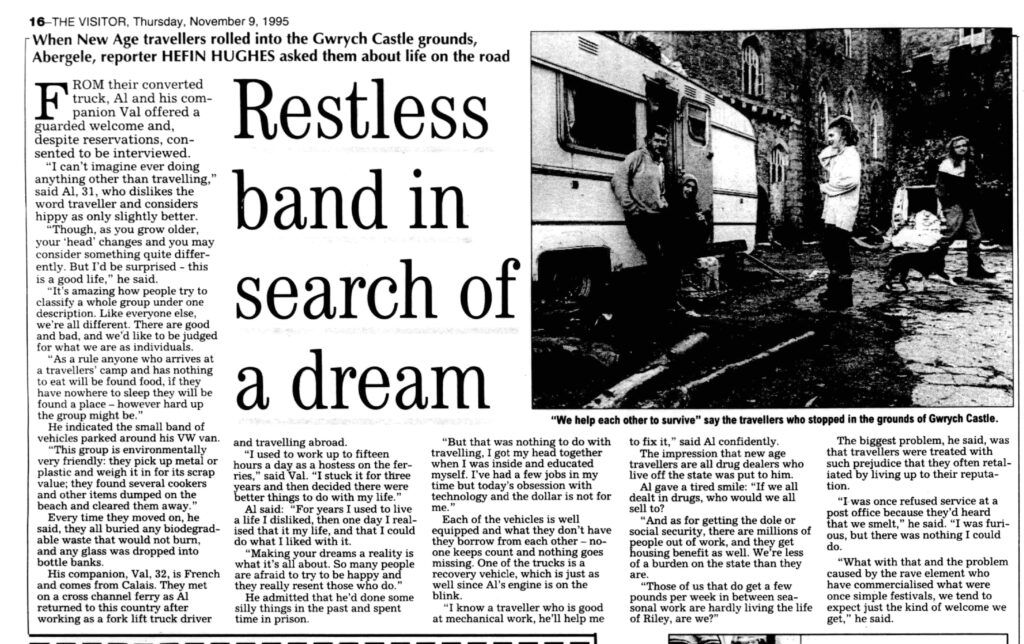
A campaign to save the castle
Later that year 11-year old Mark Baker began a campaign to drum up interest in saving the castle. He contacted several influential people including Tony Blair and the Prince of Wales. It all generated a lot of media interest which forced people to sit up and take notice.
In 1997 the castle was granted a Grade 1 listing putting it in the top 5% of Welsh historic monuments. A few weeks later the travellers were kicked out but their two-year “residency” had seen the total destruction of the castle which was now an empty shell with no roof. Only the stone walls remained. Concrete blocks were installed across the entrance to prevent their return.
Mark continued his campaign by writing a book and setting up a website. An official preservation trust was formed. Through all this time it was still owned by the absentee Californian businessman but in 2006 the trust “forced” him to sell the site to Clayton Hotels who proposed rebuilding the derelict structure. After spending £500,000 to clean up the site, they went bankrupt.
In June 2018 the trust were able to buy the castle after the National Heritage Memorial Fund (NHMF) stepped in with a grant of £600,000. A major grant was also received from the Richard Broyd Charitable Trust. The castle hit the headlines during the COVID pandemic due to its two-year run as the filming location for I’m A Celebrity… Get Me Out of Here.
In 2023 the trust were awarded £2.2 million of funding by the National Heritage Memorial Fund (NHMF). The money will allow for urgent repairs to be carried out. Mark Baker, now Dr Mark Baker, is still involved and has been chairman of the trust for many years. One of the old lodges, sold off in 1975, was bought back by the trust and can now be rented out as holiday accommodation.
Visit the trust website for more information on the latest developments.
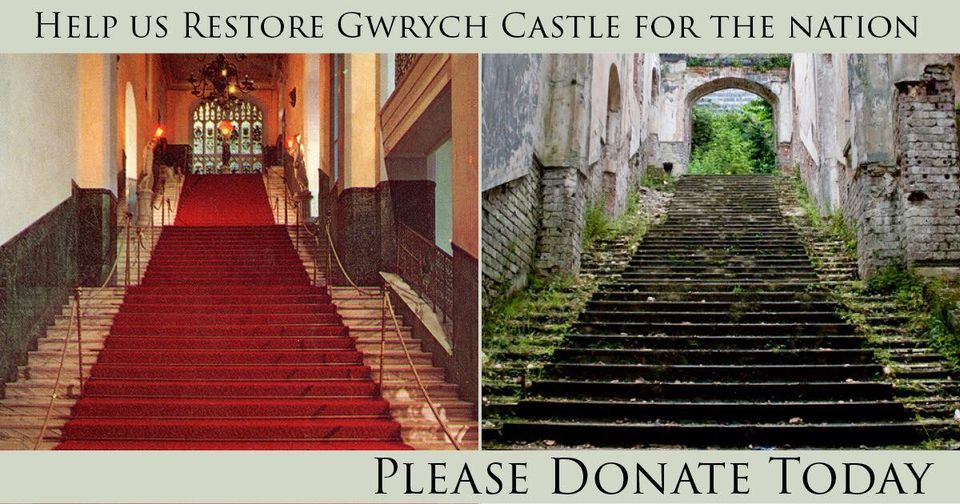
Updates:
In 2001 Turpin was inducted into the International Boxing Hall of Fame and in the same year a bronze statue of him was unveiled in Warwick’s Town Square. The official unveiling ceremony was performed by Sir Henry Cooper.
Leslie Salts did open the miniature railway on Fleetwood seafront, but not until 1954, and without the involvement of Turpin. It only ran for two seasons and then closed due to lack of business. The steam loco was moved to Gwrych Castle.
The steam locomotives used on the Leslie Salts miniature railways at Gwrych, Great Orme and Fleetwood all still survive today in private ownership. The railway track at Gwrych also apparently still survives, rusty and overgrown.
A brief history of the summit complex on Great Orme
Described in the 1980s as “an environmental and commercial disaster from the day it opened” the 9-bedroom hotel on Great Orme summit was built in 1909 by local businessman Thomas McDonald. Originally known as the Telegraph Hotel it even had it’s own 18-hole golf course.
The complex was requisitioned for wartime use as an RAF radar station and reopened again in 1946. The hotel remained closed, never to reopen, and the golf course was sold off. So it simply became a restaurant, bar and gift shop.It was owned by Turpin between 1953 and 1960.
It was then sold to the council for £9,000 and they rented it out on a succession of short 3-year leases. The Llandudno Fortes company held the food concession whilst others held concessions for the amusement arcade and gift shop. By the 1970s the complex had become very rundown. An official from the council described it as “a dismal, neglected and generally unpleasant structure”. The council sold it in 1980 to the Llandudno Fortes company.
It’s still open today and has undergone major refurbishments. It now looks very nice inside. In 1991 the Randolph Turpin bar, aka Randy’s Bar, was reopened along with a selection of memorabilia and photos celebrating the life and career of its former owner. The bar closed during COVID and never reopened. At the time of writing (2024) the bar is still closed.
We’d love to hear your memories and stories of Gwrych Castle. Please feel free to leave your comments below.

Leave a Reply